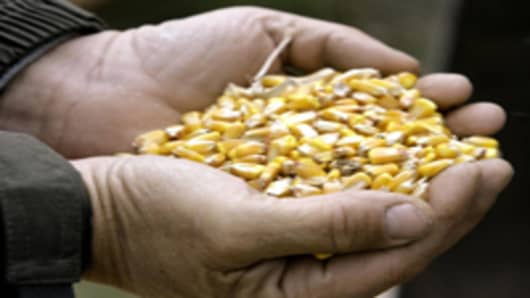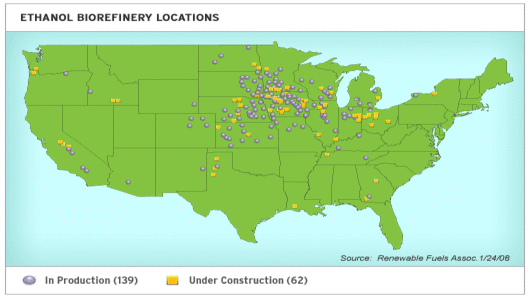The recent run-up of basic food staples — 240 percent since 2004 — has muddied the prospects of future support for food-based ethanol, which has been blamed for 10 to 30 percent of the price spike. Presumptive Republican presidential nominee John McCain says he would freeze ethanol mandates at current levels. (His Democratic rival, Sen. Barack Obama, has generally been less critical.) Future support will be shaped by the debate about how much ethanol has added to food prices increases — as will the size of crop harvests.
How is corn-based ethanol made?
Making ethanol, or ethyl alcohol — more generally "spirits" — is among man's earliest ventures into value-added processing, with a new industrial twist. It is the process of making alcohol through the fermentation of starch, found in corn and similar grains, or from sugar-based feedstocks like beets or sugar cane.
The process has been considerably refined in recent years but follows a basic recipe. After being ground into flour, or "meal", it is slurried with water to form a "mash" to which enzymes are added to convert the starch to dextrose, a simple sugar. This is then processed in a high-temperature cooker to reduce bacteria before being transferred to fermenters where yeast is added and the conversion of sugar to ethanol and carbon dioxide (CO2) begins. Continual technological innovations are reducing energy use and production costs on top of reducing emissions.
There are a range of next generation biofuels. Advanced biofuels are non-ethanol fuels derived from cornstarch with 50 percent less greenhouse gas (GHG) emissions, while cellulosic biofuels are made from agricultural waste streams, such corn stalks, rice straw and other new "energy crops" such as fast-growing trees and grasses.
Where are the biofuel plants and who are the large players?
There are 358 known biofuel plants in the US, but only a third have actually been commissioned, according to New Energy Finance, which conducted an extensive industry survey. Most are located in the Midwest, close to abundant supplies of corn and other crops.
A bulge of new capacity is expected to come on-line through the end of 2008, which will gradually taper off through 2009. Overcapacity during the next two years could dampen financing for projects beyond this time; at least a dozen projects have been put on hold or abandoned altogether, in some cases because of soaring corn prices.
In any case, federal mandates were conceived to keep pace with projected supply. The RFS calls for 13.2 billion gallons of corn-based ethanol in 2012 and 15 billion in 2015.
Given the relatively low cost of entry, the biofuels industry is quite fragmented. There are, however, some large players, including privately-held POET, the world’s largest ethanol producer at 1.2 billion gallons a year, Archer Daniels Midland (1.07 billion), VeraSun Energy (560 million) and US BioEnergy (310 million).




